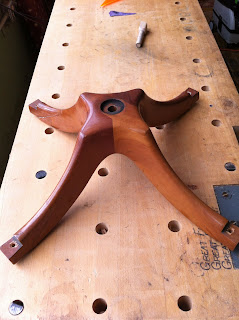Anyway, once in a while, I step over next to pillar A1, and take a shot of my bench area, as it exists. And it's interesting for me to see just how far things have come.
Checking out the space. What you can see of the space is roughly half of the length of the building, maybe 1/3 of the width, and this is the 6th floor. We ended up renting half of what you can see.
Early on... Desk in the corner, turned around so I can use the drafting board. Shelves are up, with auxiliary bench underneath, and some old library card catalog drawers under that, which contain everything from random hardware bits and pieces to a complete locking doorknob set, big hinges, string, sharpening stones, extra plane blades... and lots of other things that I have no immediate use for. Shelves were filled with all kinds of stuff, as was the auxiliary table. Just to the right, under the end of the table, is an old school tool chest with sliding tills inside. A newly built 6' bench is the primary work space, underneath the pendant lamp. Off to the left is a table that supports the grey bank of drawers that's filled with all kinds of odd hardware, and a shaving horse that hasn't figured out where to sit yet.

The space starts to hit critical mass. At this point, I've moved the big Sjoberg bench in from the machine room. The auxiliary table is off by the window, and is storing unfinished projects. The old tool chest is underneath. To the left of that is a filing cabinet. Corner bookcase now holds my NBSS tool chest, and the library card catalog full of random stuff, and a pile of other things I don't usually use. Patterns are on the wall next to it. The grey drawers are in the tall cabinet, and the table that used to support them is under the shelves, next to a plastic set of drawers that serves no obvious purpose. The shaving horse is still running wild. I have almost everything I could possibly need to do almost anything... except for space to do it in.
The exodus of stuff has begun. The shave horse and the old tool chest have been exiled to the loft. The auxiliary table has been broken down and stored. The Sjoberg bench is next to the window, with the (blocked from view) filing cabinet still by the window, and the general floor plan is much more open... open enough to build something like this bookcase. The big cabinet has been moved to the right of the shelves at this point, and the shelves have been shifted to the left. They're still full of stuff.
The open floor plan is well established at this point. The tall cabinet has been moved into the back corner of the machine room, as I've realized that anything I'm not actively using (hardware, misc junk) doesn't belong in my active work area. Well, except for the patterns that are hanging above the desk, which returned from exile as I began to realize that a) it's still a cool desk, and b)that I need to actively organize the work that's done on the bench, and the work that I need to do to organize the business. The filing cabinet's contents are in the desk drawer, and the filing cabinet is gone. Shelves are now mostly empty, so that I can use them for projects that are in motion.
The current Logjam... This project will be on its way out the door sometime soon. It has definitely tested the limits of my open floor area... and slabs that big and thick are HEAVY, which has meant that moving them around was something that I just didn't feel like doing, even as I tried to work on other projects at the same time. For the most part, everything in the frame is something I have regular use for, or something I'm in the middle of working on.
Things continue to evolve...
















































